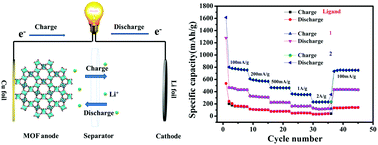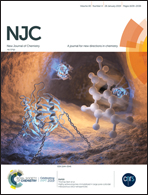Redox active azo-based metal–organic frameworks as anode materials for lithium-ion batteries†
Abstract
Two redox active azo-based metal–organic frameworks have been solvothermally synthesized from Cu(NO3)2 or Ni(NO3)2 with the ligand 1,2-bis(3,5-dicarboxyphenyl)diazene-oxide. When directly used as anode materials for lithium-ion batteries (LIBs), both the azo-based MOFs exhibit excellent electrochemical performances with high specific capacities, superior rate performances and good cycling stabilities. The two electrodes show high initial discharge capacities (1027.7 mA h g−1 for Cu-MOF 1, 1560.6 mA h g−1 for Ni-MOF 2), and still maintain approximately 40–50% of their capacities after 500 cycles and both of them exhibit high coulombic efficiencies of nearly 100%.



 Please wait while we load your content...
Please wait while we load your content...